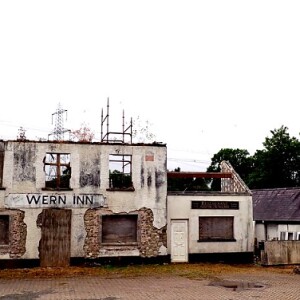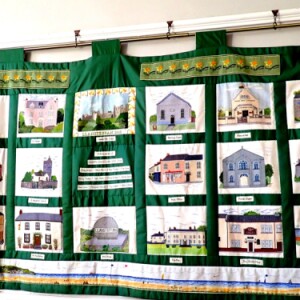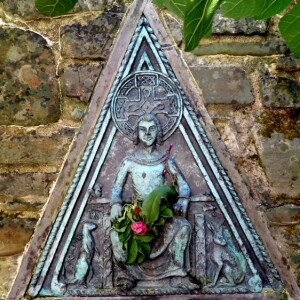Ffynnon Antwn Sant
Set off to visit a poet's grave* and found a holy well into the bargain.
Plunging through the switchback country roads of neighbouring Sir Caerfyrddin/Carmarthenshire brings surprises at almost every turn. Tiny villages with immense chapels, hilltop churches standing in circular graveyards, burnt-out pubs (one anyway, see first extra, "It wer'n inn!") and then down to the sea again at Llansteffan (previously visited in 2021)
Seeing a sign saying Cakes For Sale, proceeds to the Coastguards, I went in and got chatting the woman there, bought one of her products and admired the locally-created tapestry of village buildings (extra). As I was leaving she asked Have you visited St Anthony's Well? No, but tell me more! I replied.
So it was we followed her directions up and down a narrow lane past the castle and along a path leading towards the sea and through a door in a wall where steps led down to a damp stone cubicle beneath a fig tree. An aperture in the wall revealed a hollow through which water might pool in rainier times but now held just a scattering of shells. A wall mounted metal plaque by sculptor John Taulbut offers a pleasing rendition of the 6thC. saint accompanied by some local wildlife (extra).
The sea being already visible through the trees we followed the stream down to the beach where the shingle is made entirely of cockle shells, and walked back to village along the shore.
*Lynette Roberts, an under-acknowledged poet and writer who lived the village of Llanybri during WW2. Her work is not well known but some would say she is one of Wales' finest literary figures. I especially love her diary of the period she spent, often alone with an absentee husband until her children were born, in the remote rural surroundings where she befriended the villagers, attempted to learn Welsh and made notes on the birds and plants she saw around her.
There's a brief essay about her here but no formal biography exists.




Comments
Sign in or get an account to comment.


